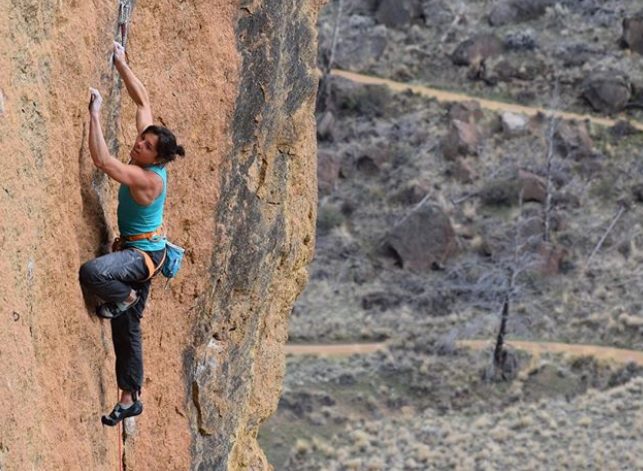Nina Caprez and To Bolt Or Not To Be 5.14

Climbing To Bolt Or Not To Be 5.14a in Smith Rock is like learning over 100 choreographed moves of a difficult dance.
Nina Caprez shares her story of working her way up all 40 metres of perfectly smooth, vertical wall.
“Six months after my illness I was standing at the bottom of this route, intimidated,” said Caprez. “I gathered all my courage and at first barely made my way to the top of this 40m route. In April 2017, I returned to Oregon and I felt ready.”
The 1986 route was the first 5.14a in North America and it focused a lot of attention on local tactics and attracted some of the world’s top climbers to Smith Rock.
The stiff 5.14 showed that there were benefits to top-down route development. French climber Jean Baptiste Tribout first sent it on Nov. 7 over three decades ago.
Alan Watts, one of America’s first big sport climbers said nearly all top climbers have tried it. The route has a number of hard moves and a number of factors must come together for it to go down.
The description on MountainProject.com reads like a move-by-move manual on how to climb it. It’s quoted below:
“The route begins tamely enough, with 3 bolts of fairly mellow 5.12- liebacking up a series of left-facing sidepulls. There is a difficult left-hand mono move below the first bolt, and an easy sinker mono for the right-hand at the 3rd bolt. The first difficult clip comes at the fourth bolt, just before the first crux, a 5.12 rightward traverse on sharp, purple crimps and un-inspiring foot divots. Opposing sidepulls and high-steps lead to a 1/4” polished crimp and the tenuous fifth clip.
“The real business comes in the next few bolts. For crux #2, gaston up and left to a series of 5.13- deadpoints to thin, sharp crimps and a core intensive clipping stance. Clip #6, chalk up and kiss your skin goodbye as you tickle the 1/8” crimps of the next 5.13 crux. Moving from 6 to 7 is the hardest bit of climbing, and it comes with a considerable pump, but good balance is the key to reaching the sickle-shaped sidepull and an extremely insecure clipping stance.
“A brief shake & chalk is possible here, before continuing thru crux #4 via sequential 5.12-ish footwork & hip shifting. Clip the 8th bolt with ease, then a series of super-high-steps and long lockoffs lead to the ninth bolt and the first real rest: a rounded 1” crimp with decent feet.
After a good shake, beta-intensive 5.13- crux #5 heads up and left on rounded crimps and long cranks, to a slopey pod rest at the tenth bolt. From here to the chains is considered 5.12d, but should not be underestimated, as there are many heart-breaking moves in the last 5 bolts.
“A few moderate moves lead to a large bear-hug flake at the 11th bolt, and one final shake before the last 5.12/13- crux. Delicate footwork and tiny crimps work up & left to the “crescent-shaped” hold, an awkward clip and one last hard crank to a series of horizontal crack pods.
“From here, things ease somewhat as the pump builds. Long sequential lockoffs between bigger holds with better feet keep things moving chain-ward, but don’t allow for any real “Thank-God” rest. After clipping 14, an awkward & balancey step left leads to an ascending leftward traverse, crossing delicately to large slopey pockets and a bomber clipping jug on the arete.”


